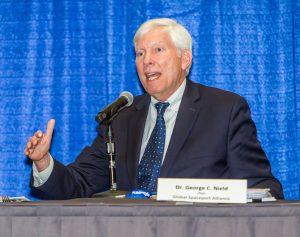
Chairman’s Message
Ever since July 2011, when the Space Shuttle Atlantis rolled to a stop on the runway at the Kennedy Space Center after completing its final mission, no American has been able to travel to space while riding on an American rocket. That long and unfortunate situation finally came to an end last month, with the successful test flight of Virgin Galactic’s VSS Unity from the Mojave Air and Space Port in California.
I had the opportunity to be out at Mojave for that historic achievement, and it was a very special experience. Given the extensive preparations necessary to prepare the flight and ground systems for the mission, and the uncertainties surrounding the weather conditions (especially the predictions for upper-level winds), Virgin Galactic had not widely publicized the launch date ahead of time. But Richard Branson was there, along with a number of his friends and family members. Also in attendance was Anousheh Ansari, who had helped to fund the $10 million Ansari XPrize that had first helped to spark interest and attention in commercial spaceflight back in 2004. Two years later, she ended up buying a ticket to fly to the International Space Station onboard a Russian Soyuz rocket, where she inspired millions through her observations and reflections as the first person to ever blog from space.
On the afternoon of December 12, the day before the tentatively scheduled launch, we were able to tour the FAITH (Final Assembly Integration Test Hangar) facility, where WhiteKnightTwo and SpaceShipTwo were being thoroughly checked out. George Whitesides, the CEO of Virgin Galactic and the Spaceship Company, and Enrico Palermo, the President of the Spaceship Company, were our tour guides, and they pointed out many of the innovative features of the vehicles that are intended to allow ordinary people (or at least anyone who can afford to buy a ticket!), to personally travel to space. We also had a chance to see the airframes for two additional spaceships that are already under construction. Remember, Sir Richard wants to create the first true “spaceline”, so his plan is to operate a fleet of several spaceships and at least one more carrier aircraft in order to accommodate the expected demand.
Takeoff was targeted for around 7:00 a.m. on the morning of December 13, and I was joined by several hundred other eager onlookers who had checked in well in advance. Most of us took advantage of the extra time by greeting old friends or introducing ourselves to the next generation of space enthusiasts. It was a struggle to stay warm in the pre-dawn chill of the Mojave flight line, but you could definitely feel the excitement in the air. Finally, it was time for takeoff, and the crowd cheered wildly and snapped photos with their smartphones as the WhiteKnightTwo left the ground for the planned one-hour climb to altitude. After SpaceShipTwo was released at about 43,000 feet, pilots Mark “Forger” Stucky and Frederick “CJ” Sturckow fired the rocket engine for approximately 58 seconds. From the ground, you could see a vertical white contrail, heading for the stars, and topped by a bright yellow exhaust flame. Before gliding back to the runway for a successful landing, the crew reached a maximum velocity of close to three times the speed of sound and a peak altitude of roughly 51.4 miles, high enough to qualify for FAA commercial astronaut wings.
With the crew back on the ground, it was all smiles, handshakes, and back slaps for those of us in attendance. After the obligatory congratulatory comments from Sir Richard and several other dignitaries, the program was officially over. But instead of immediately heading for the parking lot, most people seemed to want to hang around and continue the celebration. To me, it felt a lot like the home team had just won the championship football game with a last-second touchdown pass. I guess it can take time for the adrenaline to wear off and the significance of what had just happened to truly sink in. All in all, it was a very exciting event, and one that I hope all of you will soon have a chance to experience for yourselves. I can’t wait to see launches like this taking place on a regular and frequent basis at spaceports all over the world. In fact, that’s what the Global Spaceport Alliance is all about!
Dr. George C. Nield

